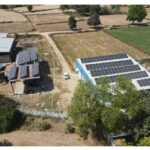India is striving to augment its renewable energy footprint, setting an ambitious goal of achieving 40 GW of solar power annually as part of a broader 500 GW non-fossil fuel capacity by 2030. Despite this, as of January 2024, the country has only installed 2.2 GW of solar power in homes, indicating that a significant portion of the target remains unmet.
The need to boost rooftop solar installations is critical, with the Ministry of New and Renewable Energy (MNRE) aiming for 40 GW by 2024 to fulfill both environmental commitments and the rising demand for solar panel price affordability. This drive for increased rooftop solar power furthers the discussion on solar panel price trends and the financial implications for Indian households looking to transition to solar energy.
Understanding the Components and Types of Rooftop Solar Systems
Components of Rooftop Solar Systems
Rooftop solar systems are comprised of several key components that are essential for harnessing solar energy. The basic setup includes solar panels, inverters, mounting structures, wiring, and optionally, batteries for energy storage.
Solar Panels: These are the primary elements that capture sunlight and convert it into electricity. There are three main types of solar panels used in rooftop systems:
Mono PERC
Polycrystalline
Half Cut Solar panels
Inverters: These devices convert the direct current (DC) generated by the solar panels into alternating current (AC), which is used by home appliances. Inverters are available in several types:
String inverters
Microinverters
Mounting Structures: These are used to secure the solar panels either on the ground or on the rooftop. The choice between ground-mounted and rooftop-mounted structures depends on the available space and the specific requirements of the property.
Batteries (Optional): For systems where energy storage is desired, batteries can be included to store excess power generated during peak sunlight hours. This stored energy can then be used during periods of low sunlight or at night.
Types of Rooftop Solar Systems
Rooftop solar systems can be categorized based on their connectivity and functionality:
On-grid Systems: These are connected to the public electricity grid and can feed excess power back to the grid.
Off-grid Systems: These operate independently of the grid and are ideal for locations without reliable grid access.
Hybrid Systems: Combining features of both on-grid and off-grid, these systems can store excess power and also have the capability to draw from the grid when necessary.
Each type of system uses specific components such as grid-tied, off-grid, grid-interactive, and hybrid inverters to match their operational needs.
Cost Considerations
The cost of installing a rooftop solar system varies based on the components used. Here is a breakdown of the typical costs for the primary components:
Solar Panels: INR 37,500 to INR 42,000 per kW
Inverters: INR 20,000 to INR 80,000 or more
Mounting Structures: INR 10,000 to INR 50,000
Batteries (Optional): INR 20,000 to INR 1 lakh or more
Understanding these components and their costs is crucial for anyone considering the installation of a rooftop solar system in India.
Factors Affecting the Cost of Rooftop Solar Panel Installation
Several factors significantly influence the cost of installing rooftop solar panels in India, which can vary widely depending on specific conditions and choices. Here’s a detailed breakdown:
Solar Panel Efficiency and Type
The type of solar panels chosen impacts the initial investment significantly. More efficient panels like Mono PERC are usually more expensive but offer better long-term savings due to higher energy output.
Inverter Type
The choice between string inverters and microinverters affects costs. Microinverters tend to be more expensive but provide advantages in efficiency and system management.
Government Subsidies and Incentives
Subsidies can reduce the cost significantly. In 2024, subsidies in India cover 20% to 70% of the total cost, depending on the region and specific programs.
Installation Charges
These can vary widely, from INR 20,000 to INR 1 lakh, influenced by the complexity of the installation and the service provider.
Additional costs also include site assessment and design (INR 5,000 – INR 10,000), permits and approvals (INR 2,000 – INR 5,000), and ongoing maintenance and monitoring (INR 5,000 – INR 10,000 per year). These factors together determine the total investment required for setting up a rooftop solar system in India.
Average Cost of Solar Panel Installation in India for 2024
The financial commitment for installing rooftop solar panels in India in 2024 varies significantly based on the system’s capacity. Detailed cost analysis shows that a 1 kW system ranges between INR 65,000 and INR 85,000, while larger setups like a 10 kW system can cost between INR 4,50,000 and INR 4,60,000. The price per watt may lie between INR 75 and INR 85, reflecting the variations due to factors such as component quality and installation complexities.
Government initiatives like the PM Surya Ghar Scheme also play a crucial role in reducing the financial burden on homeowners by offering substantial subsidies. For instance, the subsidy for a 1 kW system can be as much as INR 30,000, significantly lowering the net cost.
Here is a breakdown of costs by system size in 2024:
Solar System Size (kW)
Cost Range (INR)
1
65,000 – 85,000
2
1,05,000 – 1,25,000
3
1,50,000 – 1,70,000
4
1,85,000 – 2,05,000
5
2,30,000 – 2,50,000
6
2,85,000 – 2,95,000
7
3,15,000 – 3,25,000
8
3,60,000 – 3,80,000
9
4,05,000 – 4,15,000
10
4,50,000 – 4,60,000
Conclusion
Throughout this exploration, we’ve navigated the nuances of transitioning to rooftop solar power in India, particularly as India marches towards the ambitious 2030 renewable energy targets. The financial journey of installing a rooftop solar system is marked by a plethora of factors—not just the initial investment in components like solar panels, inverters, and mounting structures, but also influenced by system capacity, efficiency, installation complexities, and notably, the available governmental subsidies aimed at encouraging solar adoption. This layered examination underscores the importance of understanding both the micro and macroeconomic aspects of solar installations and their broader environmental implications.







